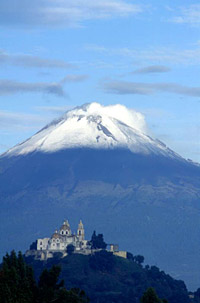 |
 |
 |
 Travel & Outdoors | November 2005 Travel & Outdoors | November 2005  
Religion Runs Deep in Mexican Town
 Anne Wallace Allen - Associated Press Anne Wallace Allen - Associated Press


| | Visitors to Cholula can see many old churches and a huge pyramid. |
Cholula, Mexico - A lot has changed since this town was founded on a flat plain in the valley of Mexico.

That founding was 1,800 years ago. Cholula's residents have learned over the years how to blend their ancient history with their modern lives to create a community that is deeply religious yet modern - and often very noisy with fireworks, church bells and the music of religious processions.

Cholula, about an hour's drive from Mexico City, is said to be the oldest continuously occupied town in all of North America. Anthropologists and town fathers say the town was officially founded in 620 A.D.

The ancient town has lots to offer visitors. Just a dozen miles from Puebla, Mexico's fourth-largest city, Cholula has several dozen elaborately decorated churches; a huge pyramid with a church on top and tunnels throughout; a yearly symphony of church bells; a religious fair that brings in an enormous market of arts and crafts; and, on a clear day, the sight of three volcanoes, one of which regularly belches smoke.

The churches are a spectacular attraction.

Local lore has it that Spanish conquistador Hernando Cortes ordered 365 Christian churches to be built when he arrived in Cholula around 1500 - a church for every day of the year. Only about 175 churches ended up being built in Cholula and neighboring villages, said Timothy James Knab, an anthropology professor at the University de las Americas in nearby Puebla who teaches a class about Cholula. But almost all the churches use fireworks to mark religious festivals, and almost all have multiple bells, so the sound of pealing bells and the sight of powerful pyrotechnics is a regular feature of life in town.

The bed-shaking fireworks can be a surprise to visitors.

"They do have a constant need for explosions," said P.J. Ryan, 70, of Wheaton, Md., who spent three months in Cholula last winter. "Usually (when there are fireworks) there's an audience, but around here that doesn't seem to matter."

Then there is the pyramid, Tepanapa. Now mostly covered by earth and plants, the huge adobe structure looks at first like a pyramid-shaped hill rising out of the flat lands near the center of town.

The pyramid was built by the Cholulteca people during the centuries leading up to 850, and features a large church on top, rebuilt several times over the past 400 years, that is still in active use. Visitors who are reasonably fit can climb the long, wide, winding stairs to the church and enjoy the views from the stone plaza on top of the pyramid - cultivated fields stretching out in one direction, and the city of Puebla in the other.

Visitors can tour the remains of the several buildings inside by walking down a long, cool, narrow corridor within.

Cholula is an important religious center, and its churches are generously decorated and scrupulously maintained. Domes and other interior walls are covered with statues of saints, children, fruit, flowers, birds, and much more in plaster, wood, gold and paint, and many of the churches feature the colorful Talavera tiles that are a famous product of Puebla.

The religious art and celebration doesn't stay inside the churches. Cholula has more religious festivals every year - about 400 - than any other town in Mexico, said Knab.

The town has plenty of secular attractions as well, starting with the Zocalo, a large shady park that is surrounded by restaurants and stores. The town is set up for visitors, with many good hotels located downtown.

Info: Mexico Tourism Board (800) 446-3942, toll-free; www.visitmexico.com. | 
 | |
 |



